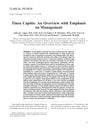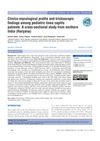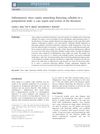TLDR Tinea capitis, a scalp fungal infection in children, is best treated with newer antifungal agents for shorter periods.
Tinea capitis, a common fungal infection of the scalp in children, especially those of African descent, was primarily caused by Trichophyton tonsuran in North America. Clinical presentations varied, including seborrheic, pustular, black dot, kerion, and scaly annular forms. Griseofulvin was the preferred treatment, but higher doses (20-25 mg/kg/day for 8 weeks) were needed due to increased treatment failures. New antifungal agents like terbinafine, itraconazole, and fluconazole offered shorter treatment courses (≤4 weeks) and were effective and well-tolerated, with gastrointestinal symptoms being the most common side effect. Adjunctive therapies, such as sporicidal shampoos, were recommended to reduce infection spread. Corticosteroid use for kerions was controversial, with recommendations for short bursts or topical application in severe cases.
 89 citations
,
May 1999 in “Pediatric Dermatology”
89 citations
,
May 1999 in “Pediatric Dermatology” New antifungal treatments for a children's scalp infection are effective and safe, but it's not decided if they will become the preferred option over the old treatment.
3 citations
,
January 2002 in “Pediatric Drugs” Tinea capitis is a common scalp infection in children, treated with antifungal medications like griseofulvin, terbinafine, and fluconazole.
 1 citations
,
October 2022 in “Asian journal of medical sciences”
1 citations
,
October 2022 in “Asian journal of medical sciences” Trichoscopy is a valuable, quick, and non-invasive tool for diagnosing tinea capitis in children.
May 2024 in “Journal of Fungi” Tinea capitis in adults, especially postmenopausal Black women, needs prompt treatment with oral antifungals to avoid scarring.
 89 citations
,
May 1999 in “Pediatric Dermatology”
89 citations
,
May 1999 in “Pediatric Dermatology” New antifungal treatments for a children's scalp infection are effective and safe, but it's not decided if they will become the preferred option over the old treatment.
 29 citations
,
April 2013 in “Mycoses”
29 citations
,
April 2013 in “Mycoses” A young man was initially misdiagnosed with a scalp condition but was found to have a fungal infection, which improved with antifungal treatment.


